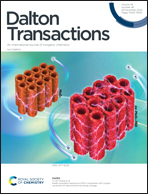Highly fluorescent scandium-tetracarboxylate frameworks: selective detection of nitro-aromatic compounds, sensing mechanism, and their application†
Abstract
Recently, exploring new luminescent metal–organic frameworks (LMOFs) to selectively detect nitro-aromatic compounds (NACs) has been a hot topic of research. Simultaneously, it is still a challenging issue to understand the sensing mechanism of luminescent MOFs interacting with NACs at the molecular level. In this work, highly fluorescent Sc-tetracarboxylate frameworks (Sc-EBTC) have been successfully synthesized through a solvothermal method. The as-prepared Sc-EBTC crystals have good thermal stability, chemical stability as well as strong fluorescence (λex = 320 nm and λem = 400 nm), and they can detect various NACs rapidly (as short as 30 s), selectively and efficiently by the “turn-off” fluorescence mechanism. The detection limits of Sc-EBTC toward 2,4-DNP and 4-NP are quantified to be 5.71 ppb and 6.26 ppb, respectively. Furthermore, to better understand the sensing mechanism, we attempt to use solid-state NMR and X-ray photoelectron spectroscopy to vividly characterize the charge transfer caused by the interaction between NAC molecules and the MOF at the molecular level. Additionally, test strips were made successfully for the practical detection of the NACs. This study demonstrates that the MOF constructed from the H4EBTC ligands might be a promising candidate for the detection of trace NACs.



 Please wait while we load your content...
Please wait while we load your content...